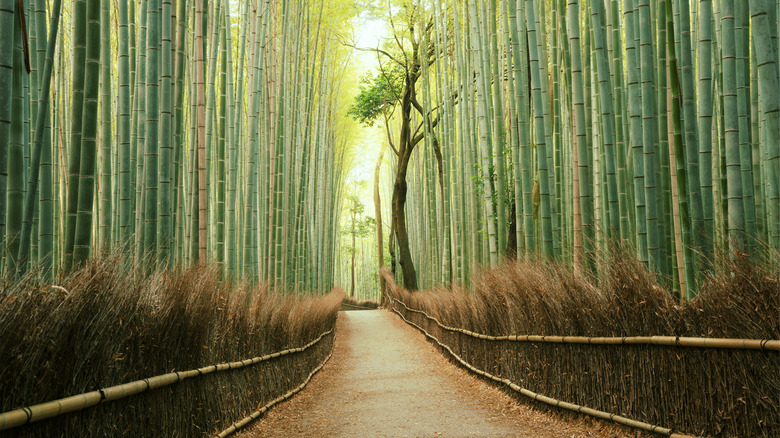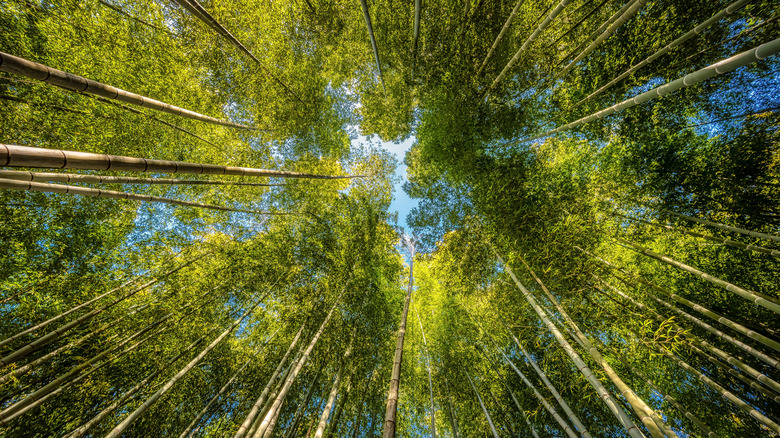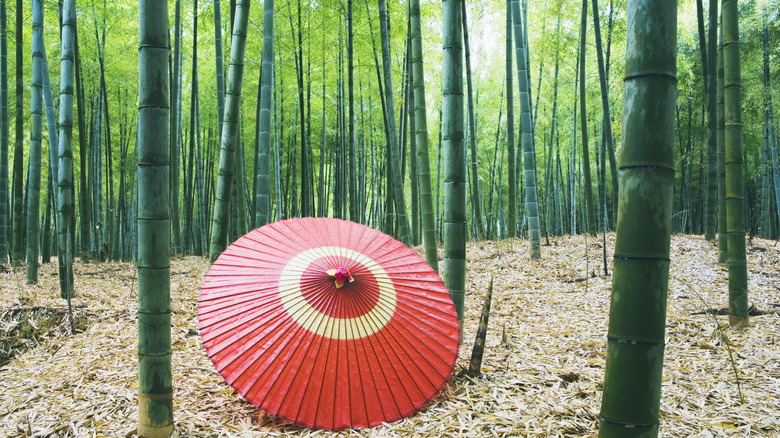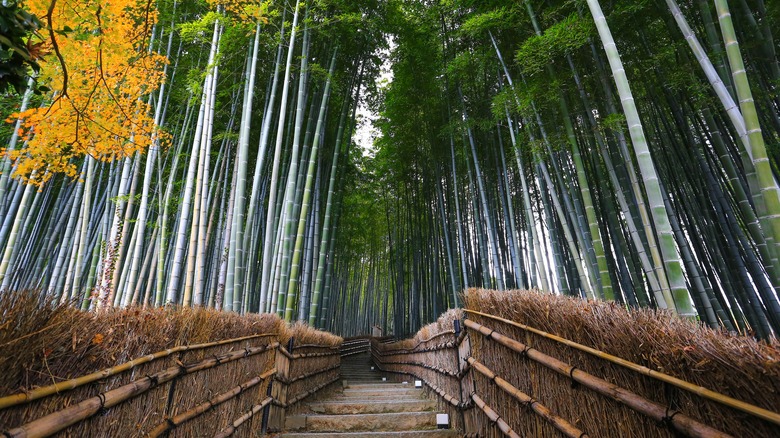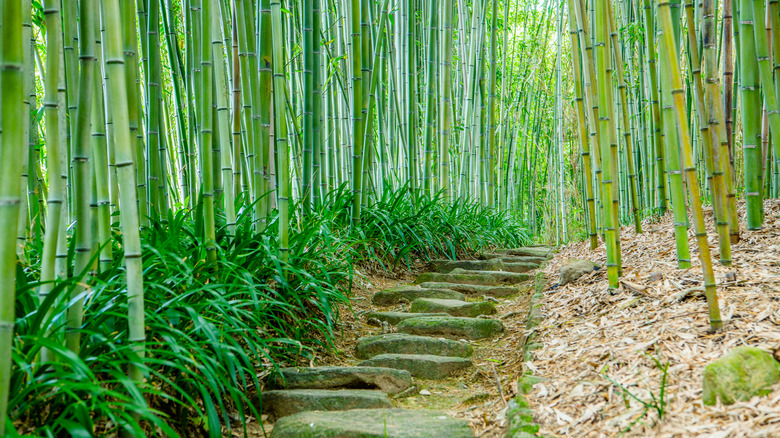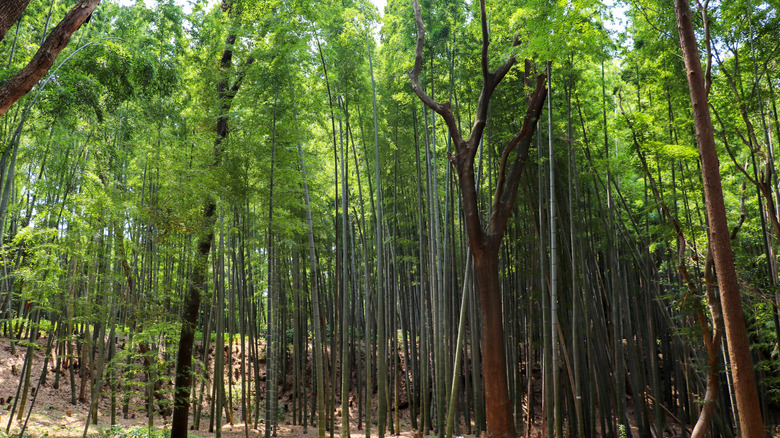Avoid Kyoto's Jostling Crowds At These Hidden Bamboo Groves Of Serenity And Silence
Tranquil scenes of serene trees lining narrow paved passageways may be the first thing that springs to mind when conjuring Kyoto's bamboo groves. However, the calming copses' international renown attracts tens of millions of tourists to the prefecture. Rather than transporting travelers to peaceful scenes, a trip to Kyoto's bamboo-lined forest lanes can stick visitors in the midst of thousands of fellow explorers — the very opposite of a zen experience. Avoid the tall trees of Japan's most popular spot, Arashiyama Bamboo Grove, and opt for lesser-known forest retreats in Kyoto.
Incorporating a stroll along bamboo groves into a wider Kyoto itinerary is a bucket list must-do. The city is one of the most popular destinations in Japan, and a visit to the country's former imperial capital is an essential addition to any culture lover's itinerary. It's an easy add-on, with Kyoto being only two and a half hours on the high-speed rail from Tokyo or less than half an hour from Osaka, the city nicknamed "Japan's kitchen" that foodies should visit.
Beat out the worst of the bamboo crowds by skipping the leaf-peeping fall foliage period or the springtime cherry blossom boom. Explore Kyoto's bamboo groves in the lowest seasons instead. In the winter, travelers undeterred by cold climes can see the bamboo forests flecked with ice and its paths doused in fresh snow. Alternatively, those immune to the heavy humidity of the Japanese summer season can catch the local cultural festivals that clog the calendar between June and September.
Kodai-ji Temple
Hidden away in Higashiyama, east of Kyoto, Kodai-ji Temple is a tribute to the maple and bamboo plants that dominate its expansive gardens. Surrounding the place of worship for followers of the Rinzai School of Japanese Buddhism, the bamboo-flanked gardens at Kodai-ji Temple are dedicated to the country's cultural heritage.
Designed to pay homage to the most remarkable traits of Japanese botany, the gardens include low-hanging maple leaves stained scarlet in the fall. The scenery is poetic, with undulating man-made hills sculpted in mimicry of a dragon's back, ponds flush with koi fish, and the gravel of its rock garden is carefully combed. Exemplifying a tsukiyama-style garden, the meticulously curated hills lead gradually upwards, carrying travelers to the bamboo forests of the inner grounds and the scenic mountain foothills. The temple's bamboo grove is smaller than its counterparts but impressive and far less frequented by the tourist crowds.
After roaming among the tall, slender trees, visitors can explore the large Kodai-ji complex in greater depth. Constructed in 1605, the temple also houses an eponymous museum, where the artworks accumulated by centuries of monastic collectors are on display. There are two teahouses hosting traditional ceremonies. You'll also find the mausoleum of the famed samurai and imperial minister Toyotomi Hideyoshi and his wife Nene, sumptuously adorned with lacquerwork of silver and powdered gold.
Take-no-Michi
Spanning just over a mile of sloping forest land, the Take-no-Michi, or Bamboo Path, is a winding bamboo-lined trail far away from the tourist throngs. It's flanked on either side by eight different varieties of bamboo hedges, demarcated by manmade barriers of bundled bamboo branches, and unique bamboo-based botanical creations like rounded hedges and shrubbery patterned in the style of ceremonial kimonos. It's lauded as one of the country's Best 100 National Walking Paths by the Japan Walking Association and protected by the government as a designated Kyoto Scenic Asset.
After walking the quiet green pathway, visitors can carry on the foliage theme at the nearby Bamboo Museum. Situated within a traditional Japanese building, with an exhibition room and ceremonial tearoom inside, the museum has a terrace where visitors can get a panoramic view of over 50,000 square feet of bamboo garden. More than 110 varieties of living bamboo are thriving here, brought in from around Japan for exhibiting to ecology enthusiasts. You can also visit the nearby Toyochikko workshop. Here, craftsmen create traditional ceremonial tools and accessories from bamboo, offering travelers the chance to learn how to weave their own bamboo baskets with expert artisans.
Take-no-Michi, the Bamboo Museum, and the Toyoshikko workshop can be found in the often-missed Muko — one of the most gorgeous cities in Japan — adjacent to Kyoto. Muko is the entryway into the southwesterly hills that form the natural border between Kyoto and Osaka, and it's worth taking a quiet trip to explore its temples, gardens, and pilgrimage hiking routes. Avoid Kyoto's tourist crush in these gorgeous gardens and explore Muko's quiet shrines after a serene stroll along the Bamboo Path.
Adashino Nenbutsu-ji Temple
Located within the same bamboo forest as the world-famous Arashiyama, the groves that shroud Adashino Nenbutsu-ji Temple are only distinguishable from their notable neighbor by the conspicuous lack of tourist crowds. Weaving slowly upward on a paved stairway of long, low steps, the narrow lane that the temple's path cuts through the forest is a relaxing alternative within the vicinity of Arashiyama's myriad attractions.
Cloistered in a cluster of tall, serene bamboo trees, the quiet Adashino Nenbutsu-ji Temple was founded some 1300 years ago. Established by one of Japan's most beloved Buddhist saints, the temple houses around 8,000 stone statues placed to commemorate the lives of those who died without family to mourn or memorialize them. Unable to revisit the world of the living during Obon, when the Japanese believe spirits are reunited with loved ones, a special ceremony is held for the forsaken souls of Adashino Nenbutsu-ji Temple. Plan your bamboo forest excursion on the 23 or 24 of August to see thousands of candles illuminating the temple grounds during the annual Sento-Kuyo ceremony.
Its proximity to Arashiyama makes the temple an obvious add-on for travelers seeking to skip the crowds while still seeing the best that the area has to offer. There's far more to Adashino Nenbutsu-ji and the surrounding region than its famed bamboo forest: stroll the scenic Togetsukyo Bridge with views of the forested hills, share the trail to Iwatayama with more than 100 pink-faced Japanese macaque monkeys, or enjoy verdant vistas on a boat ride down Hozugawa River.
Kyoto City Rakusai Bamboo Park
Devoting the entirety of one of Kyoto's green urban parks solely to bamboo, the serene forests of Kyoto City Rakusai Bamboo Park house more than 100 bamboo species. Here, the trees are bamboo, the grasses are bamboo, and even the paths are paved with bamboo — the sparse crops of visitors touring the groves are among the only features of the park not crafted from the eponymous tree. There is also a scenic bridge built from — you guessed it — bamboo. Linger on the footbridge for views of the quiet forest and the moss-fringed pond without fear of being hurried along by crowds angling for the best photography spot. An unsung attraction in the inner-city action, this quiet park in Kyoto is an ideal option for travelers seeking a serene and solo experience among droves of bamboo.
The park has its own bamboo museum and ecological garden, both dedicated to educating visitors about Japan's native botany. Citing the deep connection between bamboo and Japanese life, culture, art, and industry since antiquity, the park built its ecological garden by importing varieties from all over the country. It expounds upon that connection in the on-site Bamboo Museum, where informative panels explain the physiology and ecology of bamboo, along with traditional items crafted from bamboo on display.
Shokado Garden Art Museum
Laden across more than 200,000 square feet of museum grounds, the verdant exterior of Shokado Garden Art Museum takes some time to explore. It's home to more than 40 types of bamboo plants, accompanying a number of other native Japanese species, including blushing sakuras and amber maples. To enjoy sakura trees in all their glory, visit Japan during the best time of year to see cherry blossoms. Shokado once served as the retirement retreat of the renowned Shokado Shojo, a monk, calligrapher, tea master, and originator of the Shokado bento box. His 17th-century hermitage and guest hall can still be found within the garden bounds. These spaces are accompanied by three recreated teahouses, where you can sit and sup on a ceremonial cup while surrounded by the serene bamboo forest.
The museum's expansive grounds and location in Yawata City, a little-visited enclave between Kyoto and Osaka, mean that most visitors can roam its bamboo-lined lanes in solitude. Disturbed only by the occasional colorful koi carp flopping over the surface of the ponds, plan a route between Shokado's tea houses and historic homes in peace. A trip to Shokado Garden Art Museum can also be paired with some extra exploration in Yawata City. Made lush by its place at the meeting point of three major waterways, tunnels of cherry trees crown springtime picnickers on the river edges, and a cable car dangles over dense fall foliage as the trees seasonally shift to crimson. If you're interested in visiting Japan during autumn, these are the best destinations for a fall foliage getaway.
